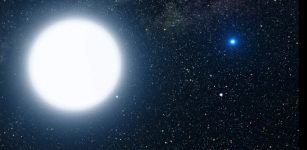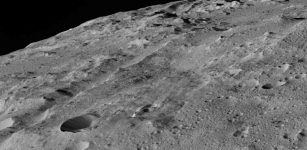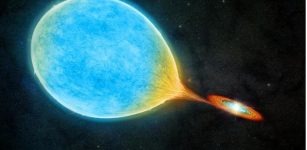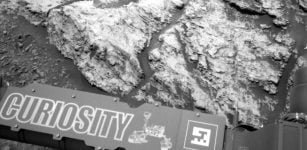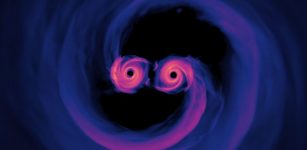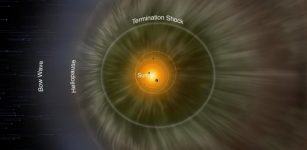Heat Glow Of Two Colliding Ice Giant Planets Seen By Astronomers For The First Time
Eddie Gonzales Jr. – MessageToEagle.com – For the first time, an international group of astronomers have seen the heat glow of two ice giant planets colliding.
They could also observe the resultant dust cloud move in front of the parent star several years later. Led by Leiden astronomer Matthew Kenworthy, they monitored the star’s brightness variations for two years after it began to dim in visible light.
Artist impression of a donut shaped cloud that was formed after two ice giant planets collided. The cloud glows dull red with the heat from the collision. An asteroid and smaller debris from the collision is in front of the donut shaped cloud. The parent star, ASASSN-21qj, is off in the distance to the left of the cloud. Image credit: Image: Mark Garlick – source
The researchers discovered by coincidence that the star had doubled in brightness at infrared wavelengths three years earlier. Their research is published in the scientific journal Nature.
The star is called ASASSN-21qj. It is named after the network of telescopes that first discovered the star fading at visible wavelengths. The star was studied intensively by a network of amateur and professional astronomers, who monitored the changes in brightness. A chance post on a social media site from an amateur researcher led to the discovery that the system doubled in brightness at infrared wavelengths some three years before the star started to fade in visible light. The US NEOWISE mission had observed this.
A collision of two planets
‘To be honest, this was a complete surprise to me,’ says Dr. Kenworthy. ‘When the ASASSN survey shared the light curve of this star with other astronomers, I started watching it with a network of telescopes and observers. Out of the blue, an astronomer on social media pointed out that the star brightened up in the infrared over a thousand days before the optical fading. I knew then that this was an unusual event.’
Leiden graduate student Richelle van Capelleveen worked on it a master’s student. She continues: ‘I worked on the light curve with Dr. Kenworthy and during our work, we realised that this could be a collision of two planets.’
The most likely explanation is that two ice giant exoplanets collided together, producing the infrared glow picked up by the NEOWISE mission, and the resultant expanding debris cloud then moved in front of the star some three years later and caused the star to dim in brightness at visible wavelengths.
Planetary collision
‘The temperature and size of the glowing material and the amount of time the glow has lasted is consistent with the collision of two ice giant exoplanets, as we infer from our calculations and computer models,’ says coauthor Dr. Simon Lock (University of Bristol, United Kingdom).
‘What’s new is that we think this is the first time we see the glow from the body that is produced by the planetary collision,’ says Dr. Grant Kennedy (University of Warwick, United Kingdom), also a coauthor on the paper.
‘This is really a fantastic opportunity to find out about the interior of giant planets,’ says Dr. Ludmila Carone from the Space Research Institute of the Austrian Academy of Sciences in Graz. Normally, giant planets hide their heavy elements under thick layers of hydrogen and helium. In this collision, however, material from the interior was ejected or dredged up into the outer regions of the body created by the merger of the two planets. Carone adds: ‘We can already conclude that a lot of water vapour was released that helped to cool the post-impact body down to 1000 K.’
Smear out
Over the next few years, the cloud of dust will start to smear out along the orbit of the collision remnant, and a tell-tale scattering of light from this cloud can be detected with both ground-based telescopes and the James Webb Space Telescope. Ultimately, the cloud of material around the remnant may condense to form a retinue of moons that will orbit around this new planet. ‘We will monitor this system closely to see what happens next,’ Kenworthy says.
Original source – Leiden University
Written by Eddie Gonzales Jr. – MessageToEagle.com Staff Writer



